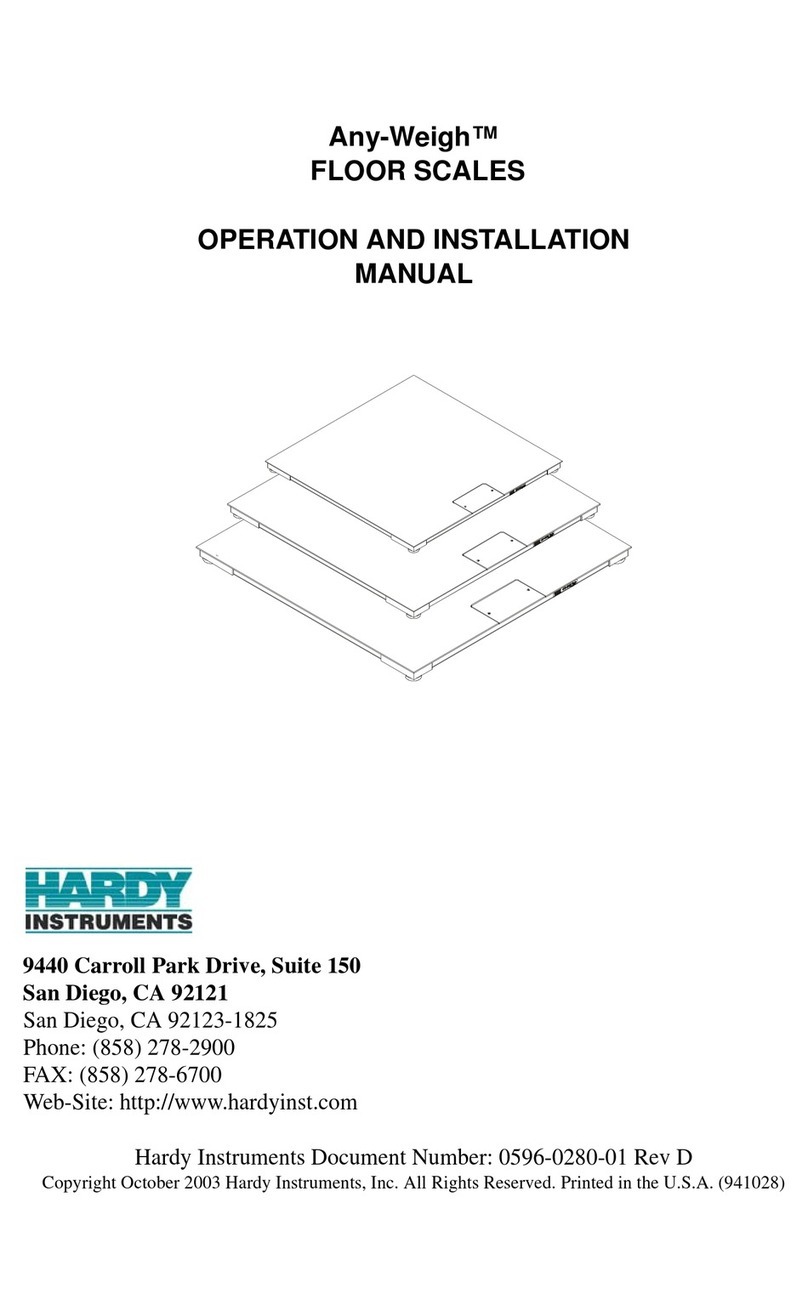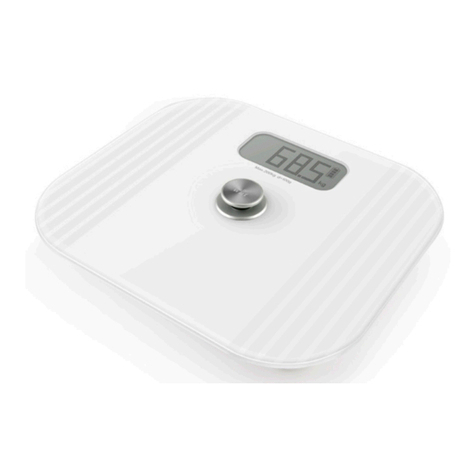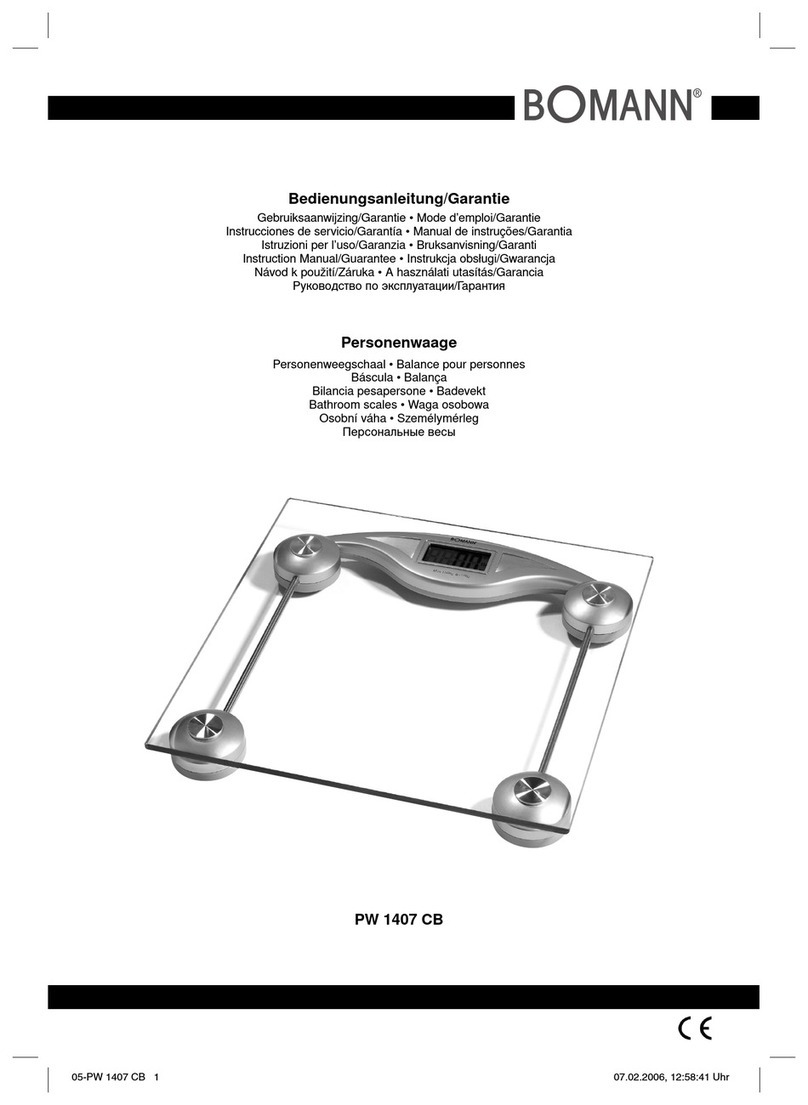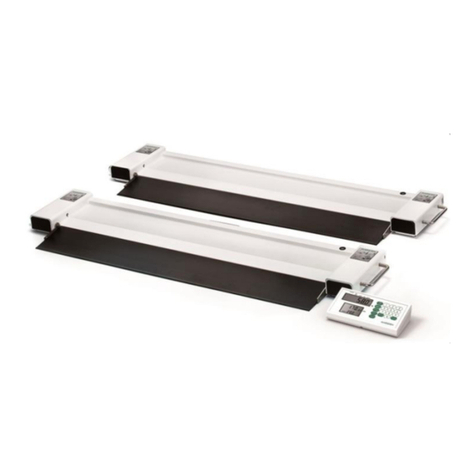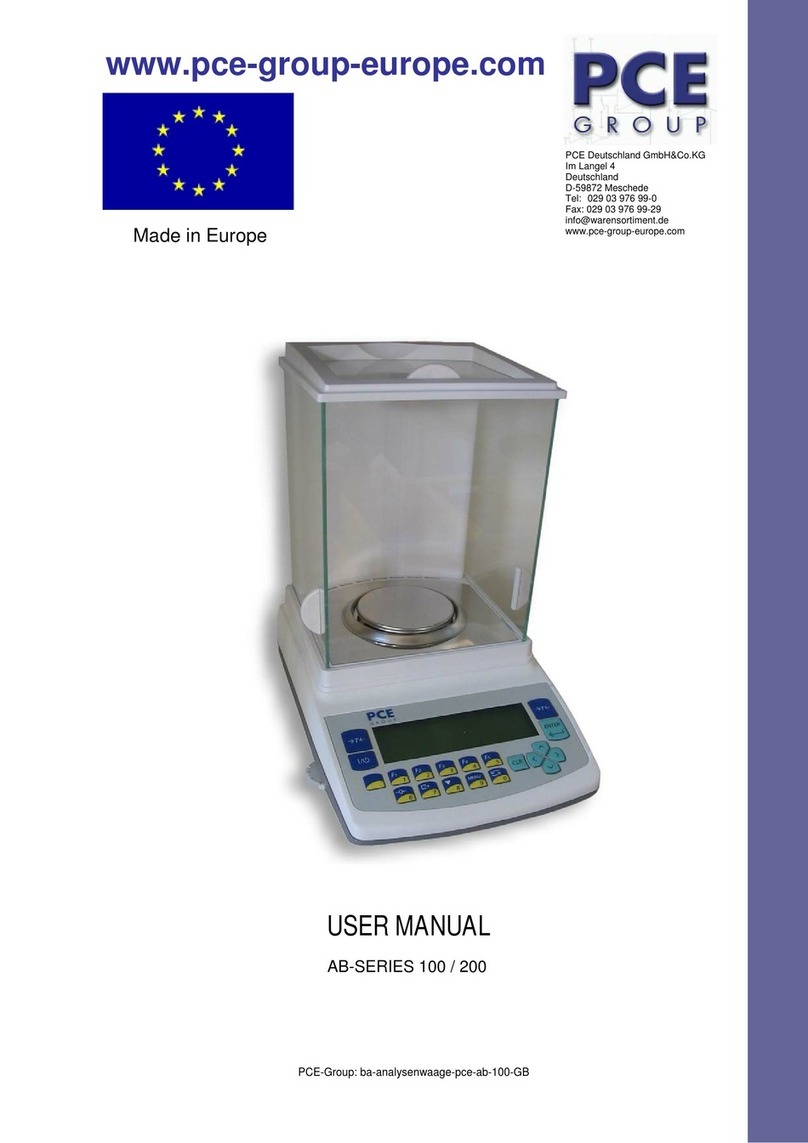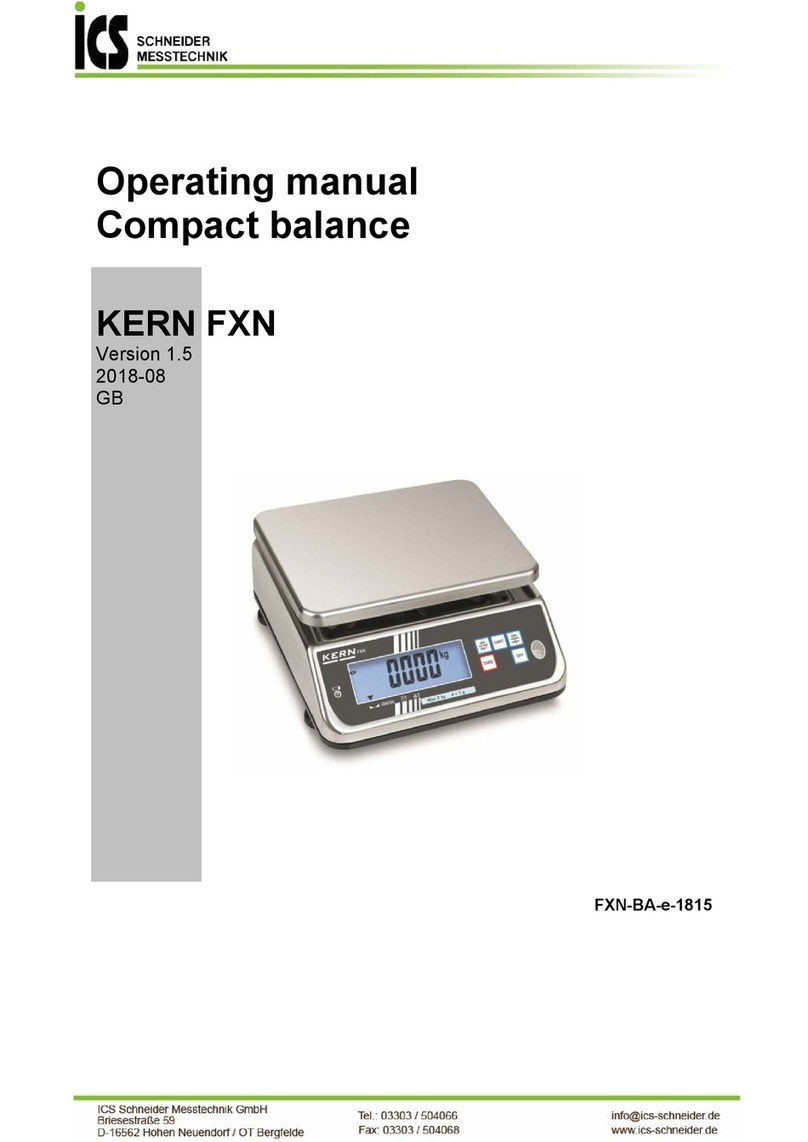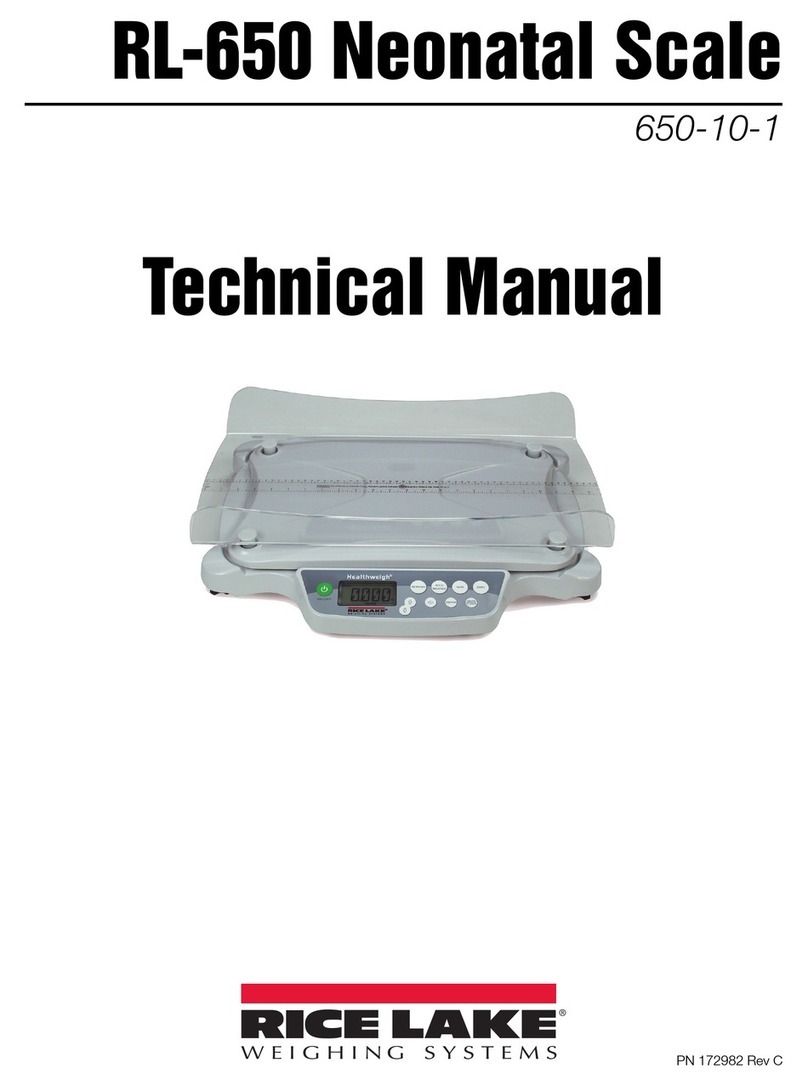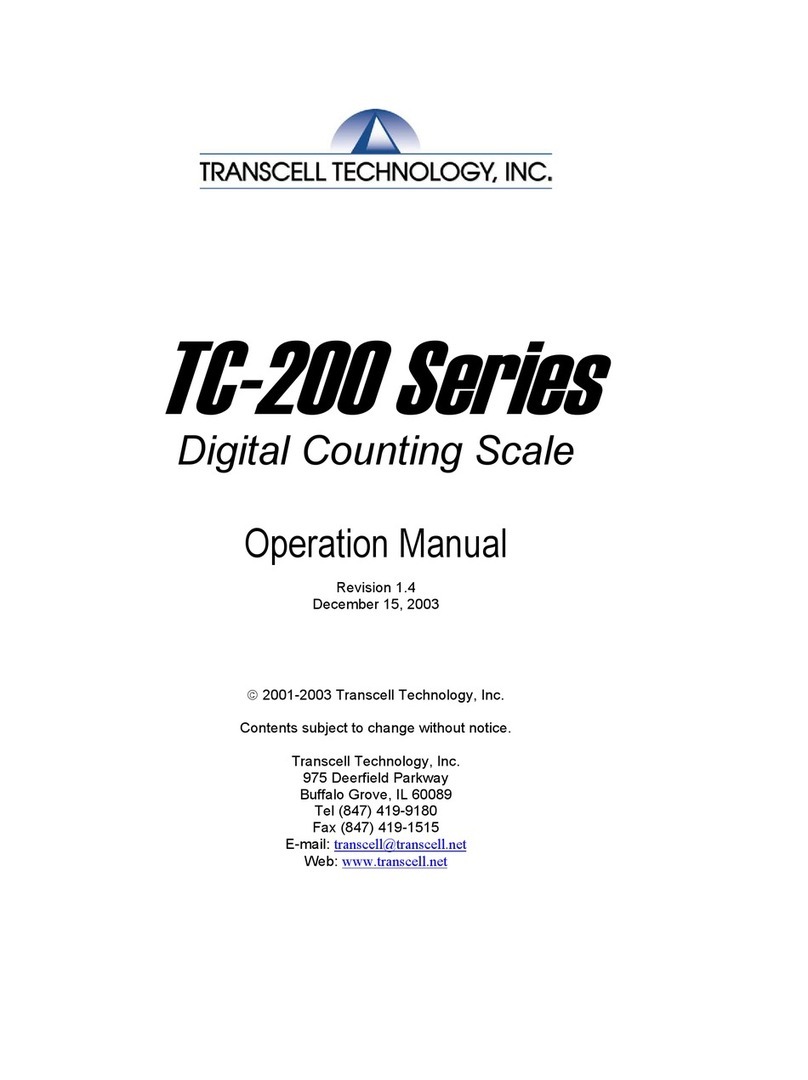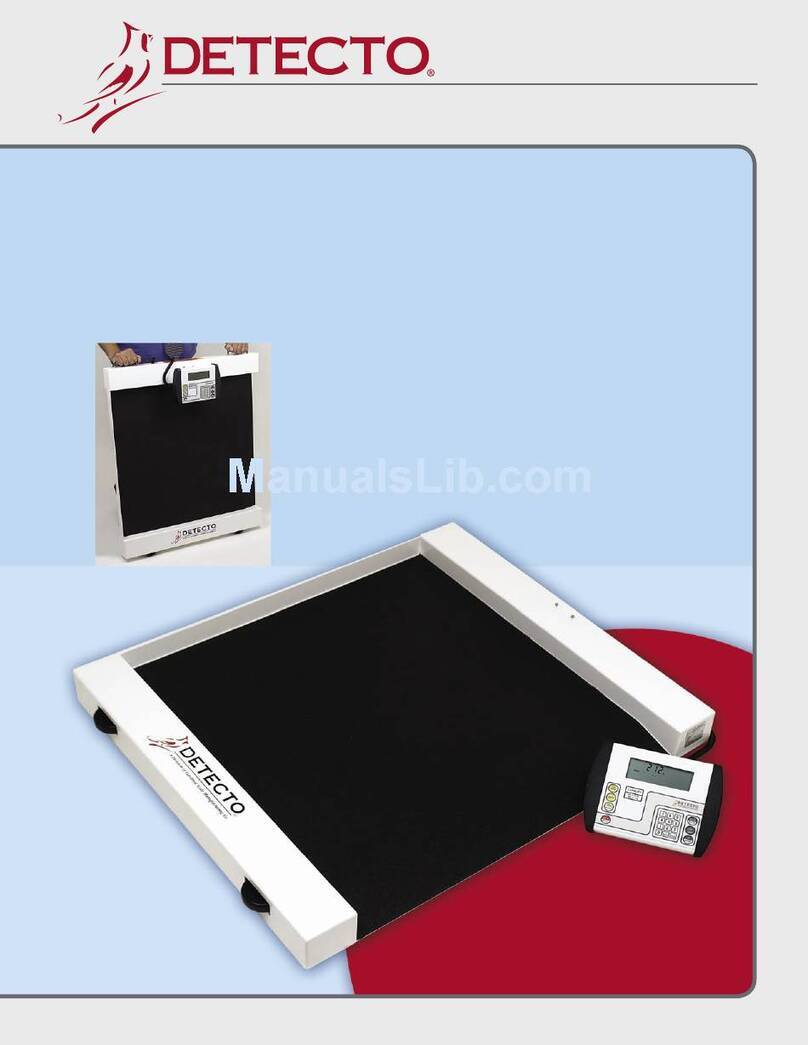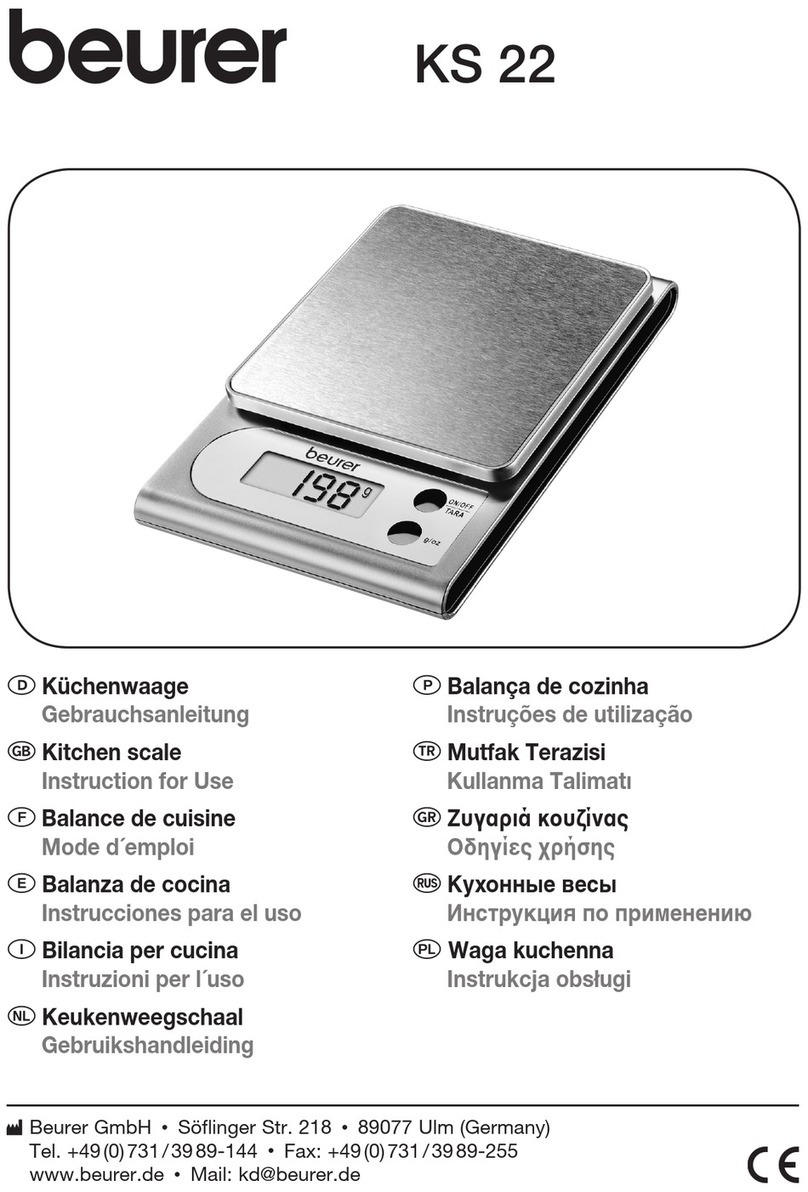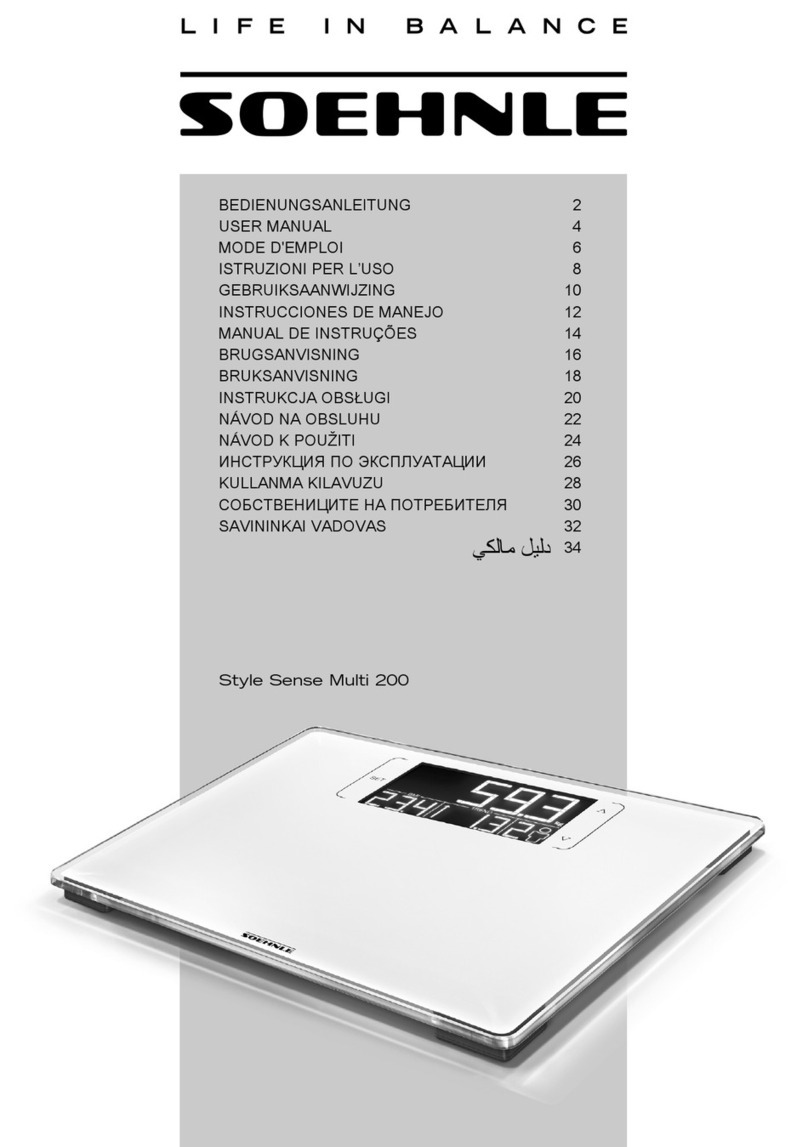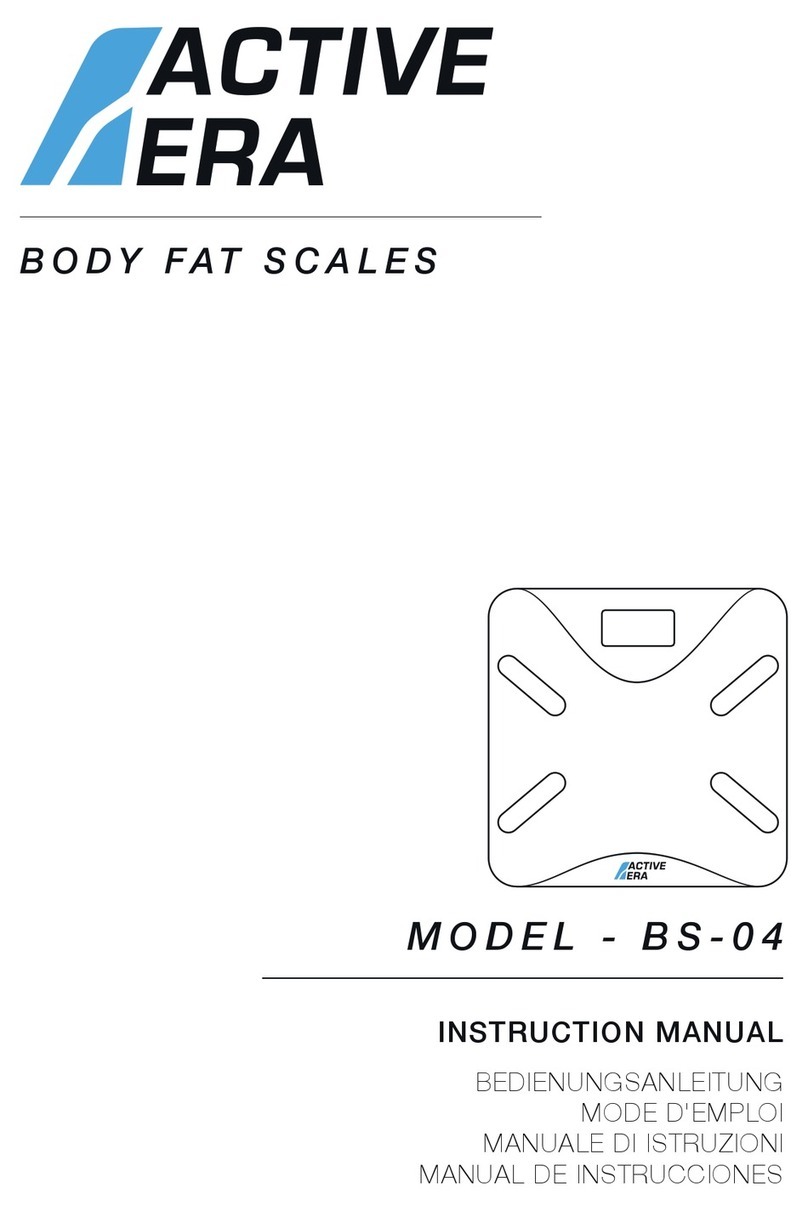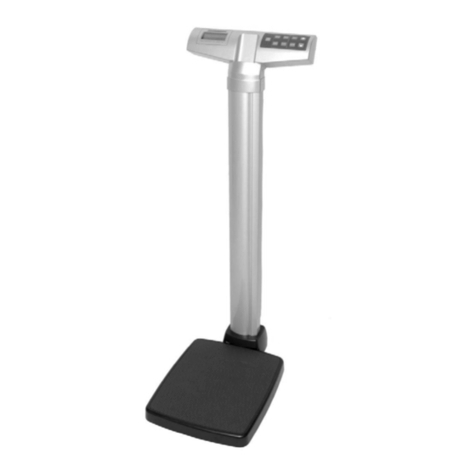Hardy Instruments Any-Weigh Specification sheet

Any-Weigh™
BENCH SCALES
OPERATION AND INSTALLATION
MANUAL
Corporate Headquarters
9440 Carroll Park Drive, Suite 150
San Diego, CA 92121
Phone: (858) 278-2900
FAX: (858) 278-6700
Web-Site: http://www.hardyinst.com
Hardy Instruments Document Number: 0596-0268-01 Rev F
Copyright December 2002 Hardy Instruments, Inc. All Rights Reserved. Printed in the U.S.A. (941028)

CAUTION:
UNPACK WITH CARE
WHEN UNPACKING, DO NOT DISCARD THE PACKING CASE OR ANY
PACKING MATERIAL, UNTIL THE CONTENTS OF THE PACKING CASE
ARE INSPECTED AND CAREFULLY COMPARED WITH THE SHIPPING
DOCUMENTS.
IF ANYTHING IS UNSATISFACTORY, PLEASE NOTIFY HARDY INSTRU-
MENTS IMMEDIATELY BY CALLING, FAXING OR E-MAILING TO:
Hardy Service Center
HARDY INSTRUMENTS, INC.
3860 Calle Fortunada
San Diego, California 92123-1825
Phone: (800) 821-5831
(858) 278-2900
FAX:(858) 278-6700
E-mail: [email protected]
Web Address: www.hardyinst.com
TO RETURN DEFECTIVE OR DAMAGED PRODUCT(S) CALL HARDY
TECHNICAL SUPPORT FOR A HARDY SERVICE TICKET NUMBER
(HST#). YOUR COMPANY NAME, ADDRESS, TELEPHONE NUMBER,
SERIAL NUMBER OF THE UNIT AND A BRIEF DESCRIPTION OF THE
PROBLEM SHOULD BE READY WHEN CALLING. FOR ALL NON-WAR-
RANTY REPAIRS A PURCHASE ORDER OR CREDIT CARD IS ALSO
REQUIRED.
IN CASE OF DAMAGE DUE TO SHIPPING, NOTIFY THE DELIVERING
CARRIER IMMEDIATELY FOR AN INSPECTION.

Table of Contents
i
Table of Contents
Chapter 1 - overview - - - - - - - - - - - - - - - - - - - - - - - -1-1
Introduction - - - - - - - - - - - - - - - - - - - - - - - - - - - - -1-1
Description - - - - - - - - - - - - - - - - - - - - - - - - - - - - - -1-1
The Stainless Steel Top Cover - - - - - - - - - - - - - - - - - -1-1
Lower Frame Assembly - - - - - - - - - - - - - - - - - - - - -1-1
Universal Scale Interface - - - - - - - - - - - - - - - - - - - - -1-1
DeviceNet™ Scale - - - - - - - - - - - - - - - - - - - - - - - -1-2
Analog Scale - - - - - - - - - - - - - - - - - - - - - - - - - -1-2
Chapter 2 - specifications - - - - - - - - - - - - - - - - - - - - -2-1
Electrical Specifications - - - - - - - - - - - - - - - - - - - - - - -2-1
Universal Scale Specifications - - - - - - - - - - - - - - - - - -2-1
DeviceNet Scale Specifications - - - - - - - - - - - - - - - - - -2-2
Analog Scale Specifications - - - - - - - - - - - - - - - - - - -2-2
Mechanical Dimensions - - - - - - - - - - - - - - - - - - - - - - -2-3
Chapter 3 - installation - - - - - - - - - - - - - - - - - - - - - - -3-1
Preinstallation Precautions - - - - - - - - - - - - - - - - - - - - - -3-1
Unpacking - - - - - - - - - - - - - - - - - - - - - - - - - - - - - -3-1
Leveling the Scale - - - - - - - - - - - - - - - - - - - - - - - - - -3-1
Universal Scale Electrical Connections - - - - - - - - - - - - - - - -3-3
DeviceNet Scale: Connecting to a DeviceNet Network - - - - - -3-4
DeviceNet Connection Wiring Diagram - - - - - - - - - - - -3-4
Analog Scale - - - - - - - - - - - - - - - - - - - - - - - - - -3-5
Chapter 4 - configuration - - - - - - - - - - - - - - - - - - - - - -4-1
SCOPE 4-1
DeviceNet Communication Configuration - - - - - - - - - - - - - - - 4-1
DIP Switch (S1) Configuration - - - - - - - - - - - - - - - - - -4-1
DIP Switch Location - - - - - - - - - - - - - - - - - - - - - - -4-1
Accessing the DIP Switch - - - - - - - - - - - - - - - - - - - -4-2
Configuring the Baud Rate - - - - - - - - - - - - - - - - - - - -4-2
Configuring the DeviceNet Node Address - - - - - - - - - - - - -4-2
Chapter 5 - Setup - - - - - - - - - - - - - - - - - - - - - - - - - -5-1
SCOPE - - - - - - - - - - - - - - - - - - - - - - - - - - - - - - -5-1
Saving to Non-Volatile Ram- - - - - - - - - - - - - - - - - - - - - -5-1
Parameters - - - - - - - - - - - - - - - - - - - - - - - - - - - - -5-1
Command Interface - - - - - - - - - - - - - - - - - - - - - - -5-4
Format of Commands (4 byte input data) - - - - - - - - - - -5-4
Examples Using the Command Interface - - - - - - - - - - -5-5

Any-Weigh™ Series Bench Scales
ii
Chapter 6 - calibration - - - - - - - - - - - - - - - - - - - - - - -6-1
Calibration of the DeviceNet, Analog and Universal Bench Scales - - -6-1
C2 Second Generation Calibration - - - - - - - - - - - - - - - - - -6-1
Test Weight Calibration (Hard Cal) - - - - - - - - - - - - - - - - - -6-1
Material Substitution - - - - - - - - - - - - - - - - - - - - - - - - -6-1
Universal Scales HI SBU Series - - - - - - - - - - - - - - - - - - -6-1
DeviceNet Scales HI SBD Series - - - - - - - - - - - - - - - - - - -6-1
THE BUTTON® - - - - - - - - - - - - - - - - - - - - - - - - - - -6-2
C2® Calibration from RS NetWorx® - - - - - - - - - - - - - - - - -6-2
Test Weight Calibration from RS NetWorx® - - - - - - - - - - - - - -6-3
Analog Scales HI SBA Series - - - - - - - - - - - - - - - - - - - -6-4
Calibration Controls - - - - - - - - - - - - - - - - - - - - - - -6-4
Coarse (ZERO) - - - - - - - - - - - - - - - - - - - - - - -6-4
Fine (ZERO) - - - - - - - - - - - - - - - - - - - - - - - - -6-4
Span - - - - - - - - - - - - - - - - - - - - - - - - - - - -6-4
Calibration Procedures - - - - - - - - - - - - - - - - - - - -6-5
Chapter 7 - OPERATION - - - - - - - - - - - - - - - - - - - - - -7-1
Scope - - - - - - - - - - - - - - - - - - - - - - - - - - - - - - - -7-1
Operating Capabilities - - - - - - - - - - - - - - - - - - - - - - - -7-1
DeviceNet Scale - - - - - - - - - - - - - - - - - - - - - - - - - - -7-1
Explicit Message Request Parameters - - - - - - - - - - - - - -7-1
Monitoring Weight Readings from RS NetWorx - - - - - - - - - -7-2
Network Status (DS1) - - - - - - - - - - - - - - - - - - - - - -7-2
Scale Status (DS2) - - - - - - - - - - - - - - - - - - - - - - - -7-2
Analog Scale - - - - - - - - - - - - - - - - - - - - - - - - - - - - -7-3
Chapter 8 - Troubleshooting 8-1
Scope - - - - - - - - - - - - - - - - - - - - - - - - - - - - - - - -8-1
Problem: - - - - - - - - - - - - - - - - - - - - - - - - - - - - - - -8-1
Scale Does Not Respond When Weight is Applied - - - - - - - -8-1
Scale Indication is not linear - - - - - - - - - - - - - - - - - - -8-1
Scale Reads Backwards - - - - - - - - - - - - - - - - - - - - -8-1
Scale Reading drifts or is Erratic - - - - - - - - - - - - - - - - -8-1
DeviceNet Scale: Module LED does not Come Back on
When Performing Calibration with The Button - - - - - - - - - - -8-2
DeviceNet Scale: Module LED is Flashing Red - - - - - - - - - -8-2
Analog Scale: Malfunction, No Output - - - - - - - - - - - - - -8-2
Analog Scale: No Change in Input - - - - - - - - - - - - - - - -8-2
Analog Scale: Output Drifts - - - - - - - - - - - - - - - - - - - -8-2
Service and Repair (All Models) - - - - - - - - - - - - - - - - - - -8-2
Index - - - - - - - - - - - - - - - - - - - - - - - - - - - - - - - -1-1

Table of Illustrations
I
Table of Illustrations
CHAPTER 2 - SPECIFICATIONS- - - - - - - - - - - - - - - - - - -2-1
FIG. 2-1 A DIMENSION- - - - - - - - - - - - - - - - - - - - - - -2-3
FIG. 2-2 B DIMENSION- - - - - - - - - - - - - - - - - - - - - - -2-3
CHAPTER 3 - INSTALLATION - - - - - - - - - - - - - - - - - - - -3-1
FIG. 3-1 LEVELING CORNERS- - - - - - - - - - - - - - - - - - -3-2
FIG. 3-2 LEVELING FEET - - - - - - - - - - - - - - - - - - - - -3-2
FIG. 3-3 LEVELING SCALE- - - - - - - - - - - - - - - - - - - - -3-3
FIG. 3-4 DEVICENET CONNECTOR - - - - - - - - - - - - - - - -3-4
FIG. 3-5 VIEWED FROM THE WIRE PIN SIDE - - - - - - - - - - -3-5
FIG. 3-6 VIEWED FROM THE SOCKET SIDE- - - - - - - - - - - -3-5
FIG. 3-7 ANALOG SCALE/OUTPUT/POWER LOOP WIRING - - - -3-6
CHAPTER 4 - CONFIGURATION- - - - - - - - - - - - - - - - - - -4-1
FIG. 4-1 DIP SWITCH LOCATION/BOTTOM VIEW - - - - - - - - -4-1
FIG. 4-2 FACTORY DEFAULT DIP SWITCH CONFIGURATION- - -4-2
CHAPTER 6 - CALIBRATION - - - - - - - - - - - - - - - - - - - -6-1
FIG. 6-1 THE BUTTON LOCATION/BOTTOM VIEW- - - - - - - - -6-2

Any-Weigh™ Series Bench Scales
II

Chapter 1 - Overview
1-1
CHAPTER 1 - OVERVIEW
Introduction Congratulations on your purchase of a Hardy Instru-
ments Any-Weigh™ Bench Scales. Behind your pur-
chase is over eighty years of quality, reliability and
technical innovation.
The Hardy Any-Weigh™ Bench Scales are designed
for table top or floor applications requiring high accu-
racy and reliability. The covers are all stainless steel
for durability. The bases have no bearings, spirit lev-
els, or moving parts that can be damaged or wear out.
The active element of the scale are precision strain
gauge load sensors.
NOTE: Any-Weigh™ is a trademark of Hardy Instruments
Incorporated.
Description The basic Any-Weigh Bench Scale consists of three
major components:
1. Stainless Steel Top Cover.
2. Lower Frame Assembly with Four Load Cells
3. Four Leveling feet.
TheStainlessSteel
Top Cover The top cover is a single piece constructed of series
300 Stainless Steel. The cover provides a weighing
surface and offers protection to the load cells and
electronics.
Lower Frame
Assembly The lower frame comes equipped with four leveling
feet, four load cells, a shock load and corner overload
protection. The lower frame is made of coated mild
steel.
Universal Scale
Interface Directly attach the scale’s 15 foot cable to any weigh-
ing instrument or controller. If interfacing with a
Hardy Controller, you can take full advantage of
WAVERSAVER®and C2®Electronic Calibration.
NOTE: WAVERSAVER®and C2®are registered trademarks
of Hardy Instruments Incorporated.

Any-Weigh™ Series Bench Scales
1-2
DeviceNet™ Scale With DeviceNet™ you can use the scale to provide a
weight output to any point on a DeviceNet™ Net-
work. This version also incorporates both the
WAVERSAVER®and C2®technologies. The
DeviceNet™ Scale comes with a fifteen inch mini-
mum length pig-tail connector.
NOTE: DeviceNet™ is a trademark of the Open DeviceNet
Vendor Association.
Analog Scale The Analog Scale provides a 4-20mA output directly
proportional to the weight reading. This version offers
a low-cost, solution for bringing analog weight read-
ings directly into a control system. The Analog Scale
requires minimal additional wiring or hardware and
comes with a 15 foot shielded 2 wire cable.

Chapter 2 - Specifications
2-1
CHAPTER 2 - SPECIFICATIONS
Electrical
Specifications
Universal Scale
Specifications Rated Output 0.900 ± 0.009 mV/V
Creep 0.030% R.O.
Excitation: Recommended 5-10 Volts AC or DC
Maximum 15 Volts AC or DC.
Total Error 0.03% of rated output
full scale
Input Resistance 297.5 ± 10% ohm
Output Resistance 250 ± 5% ohm
Safe Load Limit
At the Center
Loading Point 300% Emax
Maximum Overload
At the Center
Loading Point 400% Emax
Temperature Range
Operating -10 to +65° C
Compensated -10 to +40° C
Temperature Effect
Output 0.0015% R.O./oF
Sensitivity 0.0008% R.O./°F
Cable 15 Feet,
8 conductor,
Polyurethane Jacket,
Floating Shield

Any-Weigh™ Series Bench Scales
2-2
DeviceNet Scale
Specifications Resolution 20 bit
Update Rate 10 or 55 per second
Averages 0-255 selectable
Combined Error 0.0315% of full scale
Temperature Coefficient < 0.0005%/°C
Temperature Range -10 to +50° C
Cable 15” inches minimum with
male connector
Input Power From DeviceNet Cable: 24
VDC ± 1% 179 ma
Network/ 11-25VDC Node
Type Generic
I/O Slave Messaging Polling
Baud Rates 125K, 250K, 500K
Inputs Gross, Net, Tare
Outputs Weight - Metric/English, Zero & Tare,
WAVERSAVER®, Calibration Type,
Span Weight (Hard Cal), Cal Low
Value, Cal High Value, Number of C2
Sensors (C2 Cal), Number of Averages
Analog Scale
Specifications Loop Power 15-50 VDC Across
Scale
V+ Black
V - White
NOTE: A 15 VDC minimum would be with 0 ohm load; add
20 mV/ohm to the minimum loop voltage. A 500 ohm
load would require 25 VDC minimum loop voltage.

Chapter 2 - Specifications
2-3
Linearity* 0.11% of full scale
* Some barrier protection is required where the unit
is located in a hazardous area.
Response Time 250 milliseconds
Sensitivity 3 mV/V of full scale with
adjustment to 2 mV/V
Temperature Range 0 to +60° C
Temperature Coefficient 10.025%/° C
Cable 15 Feet
Mechanical
Dimensions The following dimensions are for reference only:
FIG. 2-1 A DIMENSION
NOTE: Cable dimension is for the Universal and Analog
scales only. DeviceNet cable length is different, see
DeviceNet Specification above.
FIG. 2-2 B DIMENSION
Six conductor shielded
15 Feet
A
B

Any-Weigh™ Series Bench Scales
2-4
ACAPACITY LB (KG)
Model Size In. (mm) 33 (15) 66 (30) 130 (60) 330 (150) 660 (300) 1300 (590)
HI 1212SBU/D/A 12x12 (298x298) X X X
HI 2424SBU/D/A 24x24 (600x600) X X X X
HEIGHT (B) in (mm)
HI 1212SBU/D/A 1.54 (39.1) 1.56 (39.6 1.75 (44.4)
HI 2424SBU/D/A 1.78 (45.2) 1.68 (42.7) 1.87 (47.5) 2.05 (52.1)
Table 2-1: DIMENSIONS

Chapter 3 - Installation
3-1
CHAPTER 3 - INSTALLATION
Preinstallation
Precautions Do not store or operate the scale out of its specified
temperature range. (See Temperature Ranges in Chap-
ter 2)
Do not store other equipment on the scale when it is
not in use or in storage.
Do not allow a build-up of debris on, around or under
the scale.
Do not set the scale in water or allow water to settle
around the scale. Provide Proper drainage.
Do not let moisture get on or into any of the electrical
interconnections.
Do not allow static or other electrical discharges
through the scale.
Do not try to remove the top plate.
Do not try to repair the scale. Contact Hardy Instru-
ments Technical Support Department for any and all
repairs.
Unpacking The Any-Weigh Bench scales are shipped fully
assembled and only require adjustment of the leveling
feet. If there is any damage to the shipping container
or to the scale, save all the packaging material and file
a report with the shipper.
Leveling the Scale Step 1. Place the spirit level across each corner
and adjust if necessary to level the corners.
(See Fig. 3-1)

Any-Weigh™ Series Bench Scales
3-2
FIG. 3-1 LEVELING CORNERS
Step 2. To level the platform, turn the leveling feet
clockwise to lower the scale corner, or
counter clockwise to raise it until you get a
level reading. (See Fig. 3-2)
FIG. 3-2 LEVELING FEET
Step 3. Place a spirit level across the center of the
bench scale. Check for level and adjust the
leveling feet if necessary. (See Fig. 3-3)
Six conductor shielded
15 Feet, (15 inches
Minimum for DeviceNet)
Spirit Leve
l
Leveling
Foot
4 Places

Chapter 3 - Installation
3-3
FIG. 3-3 LEVELING SCALE
Step 4. Rotate the spirit level 90° and check for
level again.
Step 5. Adjust the leveling feet if necessary.
Universal Scale
Electrical Connections Make sure the cable is not pinched and is clear of the
feet. The Bench Scale requires a recommended DC or
AC excitation voltage of 5 volts with a maximum of
15 volts. Wire the Scale cable to an instrument or
indicator following the color code label found on the
upper frame or as follows:
+ Excitation Red
+ Sense Blue
+ Signal Green
+ C2 Cal Gray
- Signal White
- Sense Brown
- Excitation Black
- C2 Cal Violet
WARNING USE CAUTION WHEN WIRING. MAKE SURE
TO DISCONNECT ALL POWER TO THE
SCALE. FAILURE TO REMOVE POWER CAN
RESULT IN SCALE OR INSTRUMENT DAM-
Spirit Leve
l

Any-Weigh™ Series Bench Scales
3-4
AGE, DEGRADATION OF PERFORMANCE OR
PERSONAL INJURY
DeviceNet Scale:
Connecting to a
DeviceNet
Network
Plug the connector provided with the DeviceNet Scale
to a connector on the DeviceNet Network Cable. (See
Fig. 3-4)
FIG. 3-4 DEVICENET CONNECTOR
DeviceNet
Connection
Wiring
Diagram
The AnyWeigh Bench scales are supplied with a short
cable pig tail with a (male) Micro DeviceNet Connec-
tor (See Figs. 3-5 & 3-6). The DeviceNet Pin Out
Diagram for the connector is as follows:
Pin # Description Color Code
1Drain BARE
2V+ RED
3V- BLACK
4CAN_H WHITE
5CAN_L BLUE
Table 4-1: DeviceNet Wiring Diagram

Chapter 3 - Installation
3-5
FIG. 3-5 VIEWED FROM THE WIRE PIN
SIDE
FIG. 3-6 VIEWED FROM THE SOCKET SIDE
NOTE: You should also have an installation drawing that
came with the bench scale (Drawing # 0588-0097)
which also has the wiring diagram described.
Analog Scale The fifteen-foot, 2 wire shieldedcable provides power
to the Analog Scale and transmits the 4-20 mA weight
signal. The scale must have from 15 VDC to 50 VDC
across its two loop wires at up to 20 mA (Full Scale
Output). Since all devices in the output/power loop
are in series, the minimum power supply voltage, 20
mA, must equal the total voltage drop across all of the
other devices in the loop plus 15 VDC for the ANY-
WEIGH Analog Scale.
5
1
4
2
3
5
2
3
1
4

Any-Weigh™ Series Bench Scales
3-6
Carefully note which wire is connected in the loop to
maintain correct polarity within the loop. To reduce
the change of ground loops do not connect any of the
scales signal wires to earth ground. (See Fig. 3-7)
FIG. 3-7 ANALOG SCALE/OUTPUT/POWER LOOP WIRING
RECEIVER
#1 RECEIVER
#2
RECEIVER
#3
Power
Supply
Transmitter
Analog Scale
4m A - 20m A

Chapter 4 - Configuration
4-1
CHAPTER 4 - CONFIGURATION
SCOPE The Universal Scale and the Analog Scale do not
require any configuration. The DeviceNet scale con-
figuration consists of setting the baud rate and node
address on a DIP switch which is accessible through
an access port on the bottom of the scale.
DeviceNet
Communication
Configuration
NOTE: Be sure to configure the DeviceNet Scale before plac-
ing any vessels or containers on the scale.
DIP Switch (S1)
Configuration Configuring the DIP switch sets the following:
1. Baud Rate
2. Node Address
DIP Switch
Location The DIP Switch is located through an access port on
the bottom of the scale. (See Fig. 4-1)
FIG. 4-1 DIP SWITCH LOCATION/BOTTOM VIEW
Chassis Ground
Attachment Point
CABLE
DIP SWITCH

Any-Weigh™ Series Bench Scales
4-2
Accessing the DIP
Switch Tilt the scale up until you can reach the DIP Switch
access port or if it is more convenient turn the scale
upside down so that bottom is facing up to reach the
DIP Switch access port.
NOTE: Scale must be connected to earth ground from the
Chassis Ground Attachment Point. (See Fig. 4-1)
Configuring the
Baud Rate Refer to Table 4-1 to configure the baud rate. 0 = OFF,
1 = ON (* is the default setting)
FIG. 4-2 FACTORY DEFAULT DIP SWITCH CONFIGURATION
Configuring the
DeviceNet Node
Address
Refer to Table 4-2 to configure the DeviceNet Node
Address.
Baud Rate S1-7 S1-8
125 kbps* OFF OFF
250 kbps OFF ON
500 kbps ON OFF
500 kbps ON ON
Table 4-1: Baud Rate
Other manuals for Any-Weigh
1
Table of contents
Other Hardy Instruments Scale manuals
